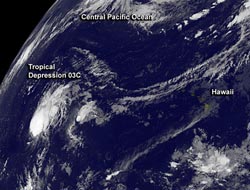NASA Sees Another New Central Pacific Tropical Cyclone

NOAA's GOES-West satellite imagery from Aug. 20 at 1200 UTC/8 a.m. EDT showed a rounded tropical depression about 1,310 miles/2,105 km west of Lihue, Hawaii. Image Credit: NASA GOES Project<br>
NOAA's GOES-West satellite imagery from Aug. 20 at 1200 UTC/8 a.m. EDT showed a rounded tropical depression about 1,310 miles/2,105 km west of Lihue, Hawaii.
The GOES image was created by the NASA GOES Project at NASA's Goddard Space Flight Center in Greenbelt, Md. The GOES image shows the strongest thunderstorms around the depression's center.
The depression was centered near 19.5 north latitude and 179.5 west longitude. Maximum sustained winds are near 35 mph/55 kph. Tropical Depression 03C (TD03C) is moving to the west-northwest at 16 mpg/26 kph and the Central Pacific Hurricane Center expects it to continue moving in that direction for the next couple of days. There are no warnings or watches associated with the depression.
Like the previous two tropical cyclones born in the Central Pacific, this one is moving west and is expected to cross the International Dateline. That means that NOAA's Central Pacific Hurricane Center will not be issuing updates on the system as it will fall under the forecast authority of the Joint Typhoon Warning Center.
TD03C is expected to continue tracking west-northwest, it is being steered by a mid-to-upper level ridge (elongated area) of high pressure to the north of the system. No change in strength is expected in the next day.
Text credit: Rob Gutro
NASA's Goddard Space Flight Center
Media Contact
All latest news from the category: Earth Sciences
Earth Sciences (also referred to as Geosciences), which deals with basic issues surrounding our planet, plays a vital role in the area of energy and raw materials supply.
Earth Sciences comprises subjects such as geology, geography, geological informatics, paleontology, mineralogy, petrography, crystallography, geophysics, geodesy, glaciology, cartography, photogrammetry, meteorology and seismology, early-warning systems, earthquake research and polar research.
Newest articles

Superradiant atoms could push the boundaries of how precisely time can be measured
Superradiant atoms can help us measure time more precisely than ever. In a new study, researchers from the University of Copenhagen present a new method for measuring the time interval,…

Ion thermoelectric conversion devices for near room temperature
The electrode sheet of the thermoelectric device consists of ionic hydrogel, which is sandwiched between the electrodes to form, and the Prussian blue on the electrode undergoes a redox reaction…

Zap Energy achieves 37-million-degree temperatures in a compact device
New publication reports record electron temperatures for a small-scale, sheared-flow-stabilized Z-pinch fusion device. In the nine decades since humans first produced fusion reactions, only a few fusion technologies have demonstrated…





















